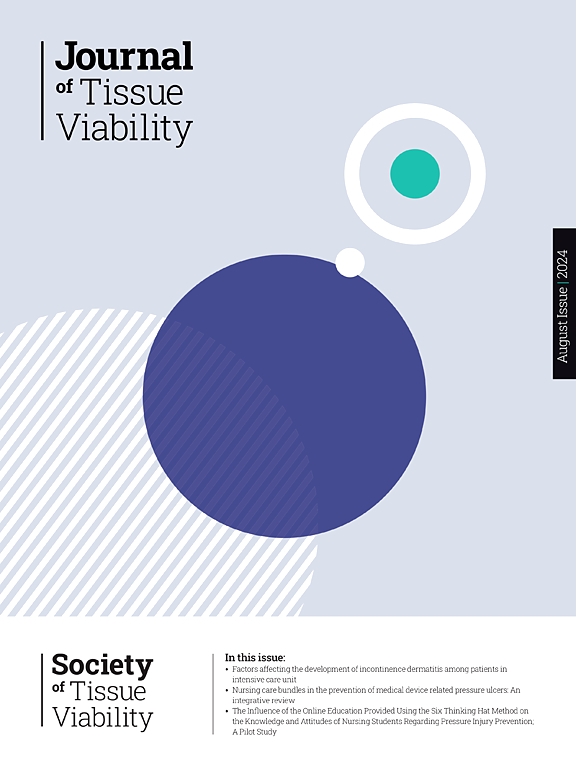Comparative effects of epidermal and fibroblast growth factor-infused collagen patches on wound healing in a full-thickness rat model
IF 2.4
3区 医学
Q2 DERMATOLOGY
引用次数: 0
Abstract
Objective
This study aimed to investigate the effects of Epidermal Growth Factor (EGF)- and Fibroblast Growth Factor (FGF)-infused collagen patches on wound healing in an experimental rat model. The focus was on acute and chronic inflammation, granulation tissue formation, fibroblast maturation, re-epithelialization, neovascularization, and collagen remodeling.
Methods
Full-thickness cranial wounds (12 mm) were created on the dorsal regions of 21 male Wistar rats and divided into four groups: Group 1 (collagen patch alone), Group 2 (collagen + EGF), Group 3 (collagen + FGF). The kaudal defects served as a chronic wound model with secondary intention healing, monitored for 21 days. Tissue biopsies were collected on days 3, 7, and 21. Histopathological evaluation included inflammation scores, granulation tissue formation, fibroblast maturation, re-epithelialization, neovascularization, and Type 1/Type 3 collagen ratio. Data were analyzed using one-way ANOVA, Kruskal–Wallis test, and other appropriate post hoc tests. Statistical significance was set at p < 0.05.
Results
Acute inflammation significantly decreased in Group 3 on day 7 (p = 0.001), while chronic inflammation was minimal by day 21 in Groups 1 and 3. Group 2 showed the highest granulation tissue formation on day 21 (p < 0.05). Fibroblast maturation peaked in Group 3 on day 21 (p = 0.004). Re-epithelialization was complete in Groups 1 and 3 by day 21, significantly outperforming Group 2 (p < 0.005). Group 3 demonstrated superior collagen deposition and the highest Type 1/Type 3 collagen ratio (p < 0.05).
Conclusions
FGF-infused collagen patches significantly improved fibroblast maturation, epithelialization, and collagen remodeling, outperforming EGF and standalone collagen patches. These findings highlight the potential of FGF as a therapeutic agent in wound healing.
表皮与成纤维细胞生长因子灌注胶原贴片对大鼠全层模型创面愈合的影响
目的 本研究旨在探讨表皮生长因子(EGF)和成纤维细胞生长因子(FGF)注入胶原贴片对实验大鼠模型伤口愈合的影响。重点是急性和慢性炎症、肉芽组织形成、成纤维细胞成熟、再上皮化、新生血管和胶原重塑。方法在 21 只雄性 Wistar 大鼠的背侧创建全厚颅骨伤口(12 毫米),并将其分为四组:第 1 组(仅胶原贴片)、第 2 组(胶原蛋白 + EGF)、第 3 组(胶原蛋白 + FGF)。将kaudal缺损作为慢性伤口模型,进行21天的二次意向性愈合监测。在第 3、7 和 21 天收集组织活检。组织病理学评估包括炎症评分、肉芽组织形成、成纤维细胞成熟、再上皮化、新生血管和 1 型/3 型胶原比率。数据分析采用单因素方差分析、Kruskal-Wallis 检验和其他适当的事后检验。结果第 3 组的急性炎症在第 7 天明显减轻(p = 0.001),而第 1 组和第 3 组的慢性炎症在第 21 天时已降到最低。第 2 组在第 21 天肉芽组织形成最多(p < 0.05)。第 3 组的成纤维细胞成熟在第 21 天达到高峰(p = 0.004)。第 1 组和第 3 组在第 21 天时完成了再上皮化,明显优于第 2 组(p = 0.005)。结论注入 FGF 的胶原贴片能显著改善成纤维细胞成熟、上皮化和胶原重塑,其效果优于 EGF 和单独的胶原贴片。这些发现凸显了 FGF 作为伤口愈合治疗剂的潜力。
本文章由计算机程序翻译,如有差异,请以英文原文为准。
求助全文
约1分钟内获得全文
求助全文
来源期刊

Journal of tissue viability
DERMATOLOGY-NURSING
CiteScore
3.80
自引率
16.00%
发文量
110
审稿时长
>12 weeks
期刊介绍:
The Journal of Tissue Viability is the official publication of the Tissue Viability Society and is a quarterly journal concerned with all aspects of the occurrence and treatment of wounds, ulcers and pressure sores including patient care, pain, nutrition, wound healing, research, prevention, mobility, social problems and management.
The Journal particularly encourages papers covering skin and skin wounds but will consider articles that discuss injury in any tissue. Articles that stress the multi-professional nature of tissue viability are especially welcome. We seek to encourage new authors as well as well-established contributors to the field - one aim of the journal is to enable all participants in tissue viability to share information with colleagues.
 求助内容:
求助内容: 应助结果提醒方式:
应助结果提醒方式:


